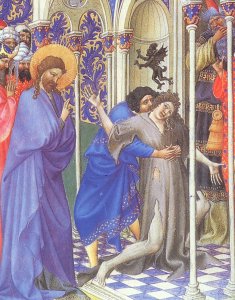|
Musée Condé, Chantilly Photograph Giraudon, Paris 
German Epilepsy Museum Kork www.epilepsiemuseum.de |
The first books of hours were made in the 12th century, following the Psalters. In them were prayers for different times of the day. They were intended for use by lay people and were not under the influence of the Church. These books, which were full of miniature paintings, were most popular in the 15th century, and the paintings took on a greater significance then being simply illustrations of the prayers, as the person commissioning the books could ask the artist to include calendars, or scenes from work and court life. In France, workshops sprang up which produced these books in series. In addition to the monastery writing rooms and the secular ateliers, the nobility took on a kind of patronage over these works. Princes and dukes called artists from different countries to their courts and appointed them to make books of hours according to their wishes. |



